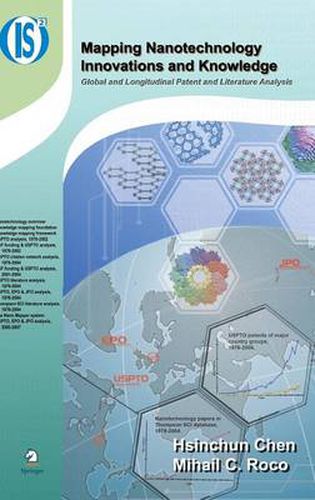Readings Newsletter
Become a Readings Member to make your shopping experience even easier.
Sign in or sign up for free!
You’re not far away from qualifying for FREE standard shipping within Australia
You’ve qualified for FREE standard shipping within Australia
The cart is loading…






This title is printed to order. This book may have been self-published. If so, we cannot guarantee the quality of the content. In the main most books will have gone through the editing process however some may not. We therefore suggest that you be aware of this before ordering this book. If in doubt check either the author or publisher’s details as we are unable to accept any returns unless they are faulty. Please contact us if you have any questions.
The field of nanotechnology has seen enormous growth since 2000 and is expected to reach $1 trillion worldwide by 2015. Through a systematic and automated knowledge mapping methodology, authors Hsinchun Chen and Mihail Roco in this book collect, analyze and report on the state of the art in nanotechnology research. The description, planning and governance of nanotechnology development require data on knowledge creation and innovation in various areas of application, how these evolve in time and what is the international context. This book aims to selectively provide such information based on the analysis of databases for science and engineering articles (Thompson Citation Index) and patents (US Patent Office in the United States, European Patent Office in Europe and the Japanese Patent Office in Japan). After a survey of the investigative methods, comparative results per countries, technology fields and research organizations are presented for articles and patents in parts of the interval 1976 to 2006.Interesting features on the evolution of major research themes and connections between research awards and patents have been obtained via longitudinal investigation of the published articles and patent data, as well as connection between NSF funding in nanotechnology and patents awarded to their principal investigators. The web-based Nano Mapper System, developed for accessing and visualizing nanotechnology patents, articles and NSF awards, is presented in the final chapter. This ground-breaking volume offers a wealth of information for professors, researchers and students in information technology interested in knowledge mapping methodology and its applications in emerging technology fields; professors, researchers and students in nanotechnology-related fields; executives, managers, analysts and researchers in the nanotechnology industry; and policy makers and analysts in federal governments interested in monitoring the global competitive landscape.
$9.00 standard shipping within Australia
FREE standard shipping within Australia for orders over $100.00
Express & International shipping calculated at checkout
This title is printed to order. This book may have been self-published. If so, we cannot guarantee the quality of the content. In the main most books will have gone through the editing process however some may not. We therefore suggest that you be aware of this before ordering this book. If in doubt check either the author or publisher’s details as we are unable to accept any returns unless they are faulty. Please contact us if you have any questions.
The field of nanotechnology has seen enormous growth since 2000 and is expected to reach $1 trillion worldwide by 2015. Through a systematic and automated knowledge mapping methodology, authors Hsinchun Chen and Mihail Roco in this book collect, analyze and report on the state of the art in nanotechnology research. The description, planning and governance of nanotechnology development require data on knowledge creation and innovation in various areas of application, how these evolve in time and what is the international context. This book aims to selectively provide such information based on the analysis of databases for science and engineering articles (Thompson Citation Index) and patents (US Patent Office in the United States, European Patent Office in Europe and the Japanese Patent Office in Japan). After a survey of the investigative methods, comparative results per countries, technology fields and research organizations are presented for articles and patents in parts of the interval 1976 to 2006.Interesting features on the evolution of major research themes and connections between research awards and patents have been obtained via longitudinal investigation of the published articles and patent data, as well as connection between NSF funding in nanotechnology and patents awarded to their principal investigators. The web-based Nano Mapper System, developed for accessing and visualizing nanotechnology patents, articles and NSF awards, is presented in the final chapter. This ground-breaking volume offers a wealth of information for professors, researchers and students in information technology interested in knowledge mapping methodology and its applications in emerging technology fields; professors, researchers and students in nanotechnology-related fields; executives, managers, analysts and researchers in the nanotechnology industry; and policy makers and analysts in federal governments interested in monitoring the global competitive landscape.